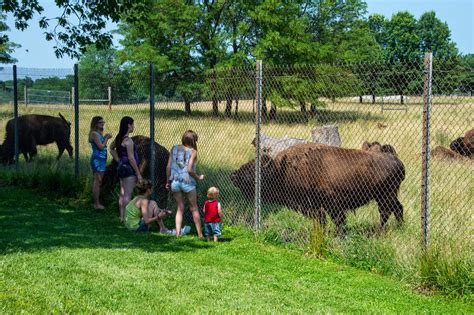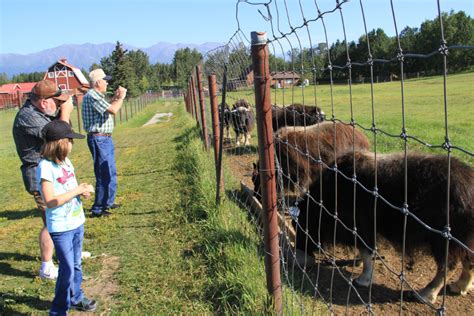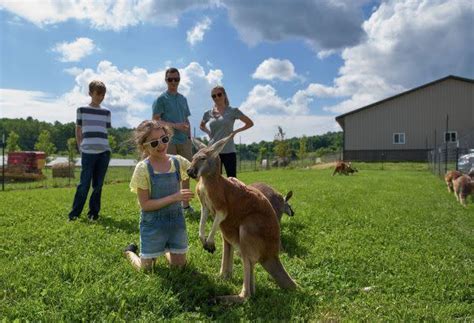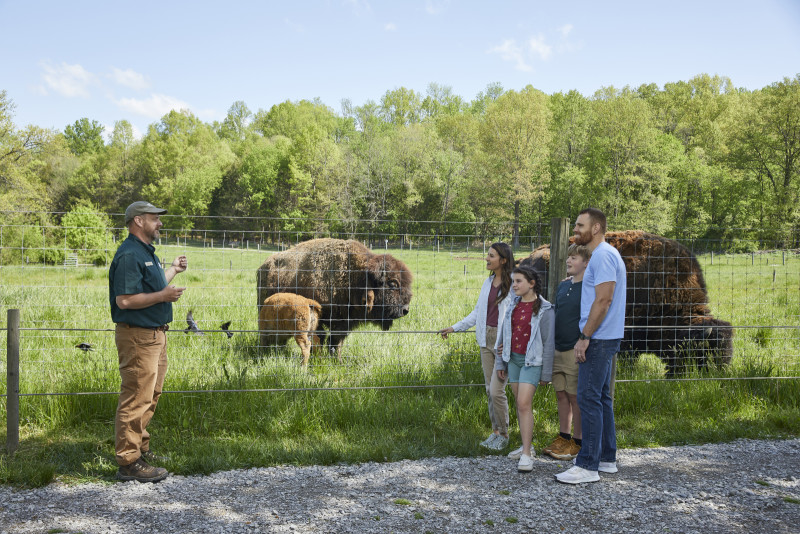Nestled in the heart of Kentucky, Big Bone Lick Campground is a hidden gem that offers visitors a unique blend of natural beauty and rich history. Known as the birthplace of American vertebrate paleontology, this site is renowned for its prehistoric significance, where ancient animals once roamed and left behind a treasure trove of fossils. Beyond its scientific importance, Big Bone Lick holds a deep cultural connection to the region’s Native American history. Today, the campground not only provides a fascinating glimpse into the past but also offers a variety of recreational activities, making it a must-visit destination for history enthusiasts and nature lovers alike.
Join ritarblog.com as we uncover the details of this topic.
1. Overview of Big Bone Lick Campground’s location in Kentucky.
Big Bone Lick Campground is located in Boone County, Kentucky, near the town of Union. Situated in the picturesque northern part of the state, it lies within the Big Bone Lick State Historic Site, which spans over 500 acres of lush landscapes and offers a serene escape into nature. The campground is easily accessible from major cities like Cincinnati, Ohio, and Louisville, Kentucky, making it a convenient destination for both locals and tourists.
This location is particularly significant due to its unique geological and historical features. The site is named after the large bones of prehistoric animals discovered in the area, which were attracted to the salt licks that naturally occur here. The campground is surrounded by rolling hills, dense forests, and meandering streams, creating a tranquil environment that invites exploration. Visitors to Big Bone Lick Campground can enjoy the natural beauty of the region while also delving into its rich historical and cultural heritage.

2. Historical significance of the site, including its connection to prehistoric animals.
Big Bone Lick Campground possesses a deep historical significance, stemming from its connection to the prehistoric animals that once inhabited the region. This site is renowned as the “Birthplace of American Vertebrate Paleontology,” a title bestowed upon it due to the remarkable discovery of large fossilized bones belonging to ancient megafauna, such as mammoths, mastodons, and giant sloths. These animals were attracted to the area by natural salt licks, essential for their survival.
The discovery of enormous bones by explorers and early settlers in the late 18th century sparked widespread fascination. These fossils, unearthed at Big Bone Lick, captured the attention of prominent figures like Thomas Jefferson. They played a pivotal role in furthering the study of paleontology in America, providing valuable insights into the existence of prehistoric creatures long before the advent of modern scientific methods.
This site is a powerful reminder of North America’s rich prehistoric past. It provides invaluable insight into the ancient ecosystems that once flourished in this region.

3. Archaeological findings and the importance of the area in paleontology.
Big Bone Lick Campground is not only a historical treasure but also an archaeological hotspot, renowned for its rich deposits of prehistoric fossils. The area has yielded an impressive collection of bones from extinct species, such as mammoths, mastodons, and giant bison, making it one of the most significant paleontological sites in North America. These findings have provided crucial evidence in understanding the migration patterns, diet, and extinction of these ancient creatures.
The archaeological significance of Big Bone Lick extends beyond its fossil record. Excavations have also uncovered artifacts related to early human activity, including tools and hunting implements used by Native Americans who once inhabited the area. This dual significance—both paleontological and archaeological—makes Big Bone Lick an invaluable site for researchers and historians alike.
The discoveries made here have not only contributed to the field of paleontology but have also enhanced our understanding of early human history in the region, solidifying Big Bone Lick’s importance as a key site for scien

4. Description of the visitor center and its exhibits on natural history.
Big Bone Lick Campground’s visitor center is a captivating hub for learning, immersing visitors in the area’s rich natural history and prehistoric significance. Thoughtfully crafted to engage visitors of all ages, the center features diverse exhibits that bring the site’s fascinating past to life.
The visitor center boasts an impressive collection of fossils, featuring the remains of mammoths, mastodons, and other prehistoric inhabitants of the region. These exhibits offer a tangible link to the past, allowing visitors to be awestruck by the immense size and scale of these ancient animals. Detailed informational panels provide insights into the lives and environments of these creatures, transporting visitors millions of years back in time.
Beyond the fossil exhibits, the visitor center showcases the region’s geological past, revealing how natural salt springs drew both animals and early humans. Dedicated sections delve into the site’s Native American history, underscoring the cultural importance of Big Bone Lick to the indigenous communities who lived and hunted in the area.
The center’s engaging exhibits and informative programs elevate the visitor experience, making it an essential destination for anyone passionate about natural history, archaeology, and paleontology.
5. Details about the camping facilities and recreational activities available.
Big Bone Lick Campground provides a diverse selection of camping accommodations, catering to both experienced campers and families seeking a comfortable outdoor retreat. The campground offers meticulously maintained sites for tents, RVs, and trailers, equipped with contemporary amenities such as electricity, water hookups, and restrooms featuring showers. Many of the sites are shaded by trees, creating a serene and scenic environment for campers.
Beyond its camping amenities, Big Bone Lick provides a diverse range of recreational pursuits for visitors to relish. The park’s extensive network of trails allows hikers to immerse themselves in the area’s natural splendor, with pathways winding through woodlands, wetlands, and open meadows. Fishing is another highly sought-after activity, with nearby lakes and streams offering opportunities to reel in local species.
History buffs will appreciate the park’s guided tours and educational programs, which explore the site’s rich past. Families and nature enthusiasts can also enjoy the park’s picnic areas and playgrounds, making Big Bone Lick a perfect destination for all.
6. Information on guided tours and educational programs offered.
Big Bone Lick Campground offers a variety of guided tours and educational programs that allow visitors to delve deeper into the site’s unique history and natural features. These tours are led by knowledgeable guides who provide detailed insights into the area’s prehistoric significance, highlighting the discoveries of ancient fossils and the role Big Bone Lick played in the early study of paleontology.
One of the most popular offerings is the fossil bed tour, where visitors can explore the very sites where mammoth and mastodon bones were first uncovered. The guides explain the process of fossilization and the importance of these finds in understanding the region’s ancient ecosystems.
In addition to the guided tours, the park offers educational programs tailored to different age groups, including school field trips and family-friendly workshops. These programs often include hands-on activities, such as fossil digs, where participants can experience the excitement of uncovering ancient remains themselves.
The visitor center also hosts seasonal lectures and presentations by experts in the fields of archaeology, paleontology, and history, making Big Bone Lick a hub for learning and discovery for both locals and tourists.
7. The site’s role in local Native American history and culture.
Big Bone Lick Campground occupies a prominent position in the local Native American history and culture. Long before European settlers arrived, this site served as a vital resource for the indigenous peoples of the region. The natural salt licks, attracting prehistoric megafauna, made this area a valuable hunting ground for Native American tribes.
Salt licks were a crucial resource for indigenous communities, serving both as hunting grounds and a source of sustenance. The salt attracted animals, providing vital nutrients that made Big Bone Lick a prime location for hunting expeditions. The site’s abundant resources and strategic location also played a significant role in trade and cultural practices. Archaeological evidence, including tools and hunting implements, has been uncovered at Big Bone Lick, shedding light on how early inhabitants utilized and interacted with their surroundings.
Big Bone Lick’s cultural significance is deeply woven into the oral traditions and stories of the local tribes. These narratives frequently mention the site’s unique natural features and historical significance. The campground’s educational programs and exhibits strive to honor and preserve this heritage, emphasizing the enduring bond between the land and its original inhabitants.
8. Preservation efforts and the importance of protecting this historical site.
Protecting Big Bone Lick Campground’s valuable historical and natural legacy is a top priority. The park actively works to preserve the fragile fossil beds and archaeological features from the damaging effects of weather and human impact. Through collaborations with paleontologists, archaeologists, and conservationists, the park ensures that all excavation and research endeavors are conducted responsibly and in a sustainable manner.
Educational programs and interpretive signage are crucial in raising public awareness about the significance of preserving Big Bone Lick. Through these efforts, visitors gain knowledge of the site’s historical and scientific importance, fostering a sense of responsibility and encouraging them to act as stewards of this unique place.
Restoring and maintaining the campground’s natural landscape not only enhances its beauty but also safeguards the ecosystems that sustain local wildlife and plant species. By blending contemporary preservation practices with community engagement, Big Bone Lick is preserved as a vital resource for future generations to discover and learn from.
Big Bone Lick Campground stands as a remarkable testament to Kentucky’s rich natural and cultural history. From its significant role in prehistoric paleontology to its deep connections with Native American heritage, the site offers a unique window into the past. With its well-preserved fossils, engaging educational programs, and diverse recreational opportunities, Big Bone Lick continues to captivate and educate visitors. Ongoing preservation efforts ensure that this historical gem remains a treasured resource, inviting exploration and fostering a deeper appreciation for the wonders of our natural and historical heritage.
ritarblog.com

